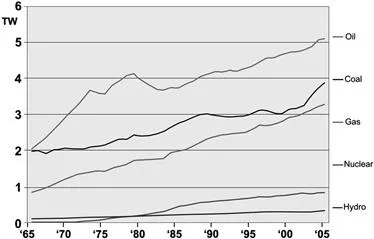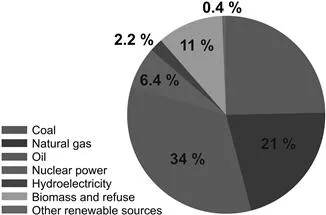![]()
Chapter 1
Introduction
Sustainable development is a comprehensive concept of development that was adopted in order to preserve the planet’s resources to the extent that will satisfy the needs of present generations without compromising the ability of the next generation to meet the same needs. The concept is comprehensive, multidimensional, and multidisciplinary, and it can be applied widely.
The study of sustainable development involves considering the whole range of relevant issues, mechanisms, solutions, and critical attitudes. Currently there is no single concept of sustainable development that can be universally applied in all areas of human activity throughout the world, and it is necessary to examine it in some sectors that are of special interest for a certain range of issues.
Since the creation of contemporary mankind, especially with the progressive development of human activities, there has been a need for the provision and consumption of certain types and amounts of energy. Every activity is related to the pending charges of energy that are created, transferred, transformed and consumed.
Energy production and consumption is a special problem in the modern world and it needs to be understood on several grounds. First of all, with a proportional increase in population there is an increasing need for the provision of sufficient energy. Given the nature of population growth and inability to stop this growing trend, the problem of providing energy for all human needs becomes global and constant [63].
Energy needs are very different in different parts of the world. The highest energy consumption, since the beginning of the Industrial Revolution in the late eighteenth century, has been found in the most developed countries [65]. Consumption of large amounts of energy has brought these countries a significant economic advantage and created the need to face a constant requirement of providing sufficient energy for future economic and social development.
Energy consumption in the world can be defined and measured on several grounds, but the most suitable is the energy consumption in the total amount of time, in some regions, as well as energy consumption from particular sources.
The total energy consumption in the world undergoes complex monitoring and control, which has multiple objectives. First of all, monitoring of energy-related indicators in the world is necessary because it provides insight into the general situation of the energy sector, helps identify the differences among particular regions, as well as understand the trends and predict future tendencies. Tracking energy-related indicators requires extremely complex measurements, so that accurate data can be obtained only after several years. The framework overview of energy consumption in the world until 2005 is shown in Figure 1.1.
Figure 1.1 Energy consumption in the world until the year 2005
Energy consumption has been measured in an organized and precise way since 1965. Power consumption in the world is characterized by three periods. In the base year 1965, energy consumption in the world was less than 5 Terawats. Out of the 5 Terawats, the largest portion was provided by exploitation of traditional sources (oil and coal), almost in equal ratios. Half that amount of energy was obtained from gas, and the least amount was obtained by exploitation of water energy. Even then, 1% of energy was obtained from nuclear power plants [64].
In the second period, which started in 1970, the energy consumption of petroleum was doubled and reached its maximum in 1980. Consumption of coal was also growing, but it was much slower and more balanced. Energy consumption increased steadily from gas, which can be partly explained by population growth and technology. The huge increase in consumption of petroleum can be understood only because of the increase in traffic. In this period (from 1980 to 1990), the consumption of water resources remained at the same levels, and the consumption of energy from nuclear sources grew slowly but not significantly.
The third period began in 1990 and is characterized by the beginning of a stable and balanced growth in energy consumption from traditional sources. Consumption of oil and gas continued to grow almost evenly, while the consumption of coal was stabilized and even slightly reduced by the end of the period. Production of energy from water and nuclear sources reached its peak in 1990 and there were no significant changes until 2000.
In the beginning of the new millennium, by a shift in the third distinct period, energy consumption from oil and gas continued to grow at the same pace, while the consumption of energy obtained from coal, after a decade of stabilization, began to grow again. At the end of the third period, in 2005, for which the precise data is available, the total world energy consumption was less than 15 TW, three times more than what was recorded 40 years earlier [75].
The reasons for increased consumption are numerous and complex and include the increase in the number of people in the world, improvement of the needs of industry and transport, inefficient consumption, and poor energy efficiency indicators. Whatever the reasons, this large consumption of energy, apart from the exhaustion of the world energy resources, has led to significant environmental consequences. All of which raises the need for a strategic redirecting in the field of energy management at all levels, with the knowledge that energy consumption is uneven in some parts of the world, as shown in Figure 1.2.
Figure 1.2 Regional distribution of energy consumption in the world
Along with the monitoring of the total consumption of energy in the world, the monitoring of energy consumption in some regions of the world is connected with a number of problems, so final estimates cannot be considered absolutely accurate, although they provide valuable information about the approximate values of energy consumption.
The highest energy consumption can be seen in the United States, Canada, Norway, and Saudi Arabia, which can be largely explained by the high level of technological development and living standards, as well as the intensity of traffic. Somewhat weaker consumption has been recorded in Russia, Scandinavia, and Australia. Compared to the first group of countries, with the highest energy consumption (indicated above), the European countries, Japan, South Africa, and Argentina, spend half that energy, followed by the Eastern European countries. Even lower power consumption has been recorded in Brazil, and the lowest in Africa and the Far East.
Energy consumption in some regions depends on many factors, but it is evident that it is related to the question of whether the region also produces the energy. Countries with the largest energy reserves are also the biggest consumers of energy, which can not necessarily be considered justified. The European countries are mainly well-developed countries, but they do not use too much energy, which is mainly due to the great efforts for rational management of energy [7].
Consumption of different types of energy also has its particularities, which are shown in Figure 1.3 [77].
Figure 1.3 Energy consumption in the world by the type of energy
From the beginning of the industrial revolution (technical and technological improvements and expansion of transport) energy from oil is mostly used, and one-third of the world’s energy needs is provided in that way. Apart from this, the trend of oil consumption is obvious. Over the years, oil consumption has continued to grow and that trend is expected to continue. Somewhat less energy is obtained by exploitation of coal (25%), but that trend has decreased, which can be explained by specific technological processes and the use of automobiles that cannot use coal as fuel. About one-fifth of world energy demand is obtained by the exploitation of gas [12].
The remaining quantities of energy are provided in the same proportion of energy from the biomass (11%), nuclear (6.4%) energy, and water courses (21%). Exploitation of nuclear energy is limited to countries where such production is allowed. The least quantities of energy are obtained from alternative sources (2.2%). The average general values have been presented, but it should be emphasized that there are significant differences in certain countries and regions [6].
Taking into account the energy dependence of developed countries and the uneven distribution of energy resources, production and distribution of energy has become a problem of particular international political and economic importance. Energy in all its forms has become a subject of international trade, numerous disputes, negotiations, and military conflicts. Since the demand for energy on the planet is constantly growing, it will occupy a more important place in global economic and political changes in the future.
With the development of awareness and responsibility of individuals and businesses and countries with the objective to respond to the growing number of environmental problems, the concept of sustainable development has been defined to seek options for successful solutions to the environmental problems, including energy exploitation and consumption, which are connected with substantial negative environmental impact. The problem of providing sufficient energy is one of the main challenges of sustainable development and clearly breaks the trend of uncontrolled energy consumption and implicitly imposes the need for changes in this field.
Sustainable development involves, among other things, the gradual implementation of specific measures to drastically change the current approach to energy production and consumption, because it implies developing new technologies, utilization of new energy sources, development and implementation of comprehensive measures of saving, and the development and implementation of numerous legal regulations, all with the aim of raising levels of energy efficiency, i.e., to stop the trend of uncontrolled consumption of energy that inevitably leads to the rapid and total depletion of existing energy resources [78]. These measures are binding for all countries that accept the concept of sustainable development and are a part of many international agreements and protocols that govern this area.
The energy problem, with the need for economic development on the one hand and the need to keep energy resources and reduce pollution on the other, requires definition of a special mechanism to manage this area, which is essential to the process of planning at all levels, in companies, across regions and countries, and in the international community as a whole [79]. Sustainable energy management, with all the elements of modern management science, along with the integration of requirements that are set by implementing the concept of sustainable development, is an effective mechanism that allows long-term planning of sustainable development. Sustainable energy management is designed so that its steps are clearly defined and measurable and its goals are specified and measurable. Only this model of management, which is based on the impact of the factors of sustainability, with clearly defined goals, provides quality monitoring of the progress of the whole process of sustainable development. However, in sustainable energy management the impact that energy exploitation and utilization of energy resources may have on other indicators of development can be monitored, measured, and kept under control.
Sustainable development consists of four subsystems that are intercon...



